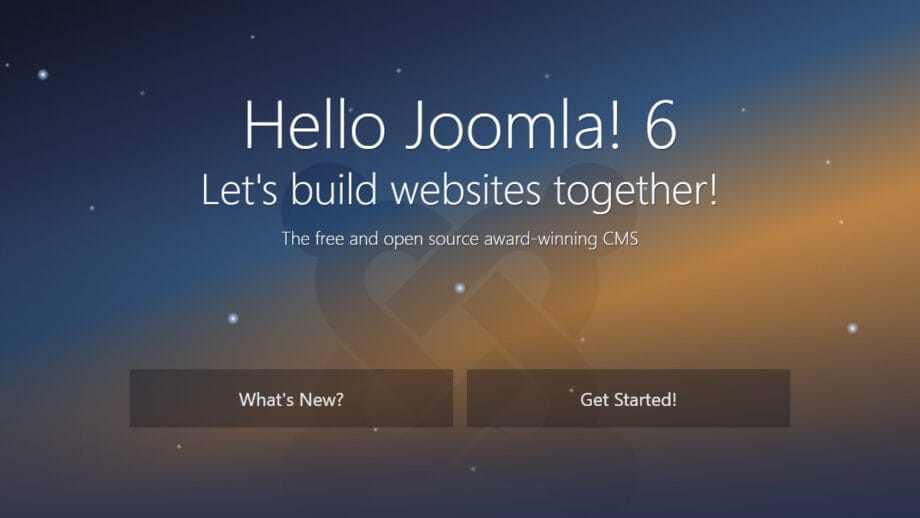Joomla 6.0 officially launched on October 14, 2025, marking a significant milestone after two years of community-driven development. According to the Joomla Project, this release focuses on stability, security, and enhanced tools rather than dramatic visual changes.
The platform brings practical improvements for modern web development. Developers can review official guides and case studies from the Joomla community to gain deeper insight into these enhancements.
At its core, Joomla 6 delivers automatic core updates secured by The Update Framework. This system prevents supply chain attacks by using cryptographic signatures to verify every update’s authenticity.
The new Healthchecker tool helps you monitor site quality beyond basic update notifications. A refactored codebase means faster loading times, and streamlined workflows make site management more efficient for development teams.
Enhanced content fields, TinyMCE 8.0.1 integration, improved SEO capabilities, and simplified migration paths round out the package. This release gives developers the reliable infrastructure needed for site health monitoring, flexible customization, and scalable growth.
Key Features and Improvements in Joomla 6
Joomla 6 brings focused improvements to content management and site administration. You get more granular control over templates and core features with this CMS release. Read on to understand the practical impacts.
Let’s break down what’s actually useful.
What is Advanced Versioning with Custom Fields in Joomla 6?
Advanced versioning in Joomla 6 now tracks changes to custom fields, tags, and categories, not just articles. You can view, restore, and compare every update across all these elements from a unified interface.
This is a genuine upgrade from the old table-based system.
Previously, versioning only captured database table data. Now it manages every aspect of an article’s structure. Teams working on sites with frequent updates gain much better oversight of how content evolves.
Restoring older content or troubleshooting mistakes becomes significantly faster. When a client asks, “What changed last Tuesday?” you’ll have the answer immediately. Collaborative environments benefit most, especially when multiple editors work on the same content with complex custom fields.
This update aligns with Joomla 6’s push toward comprehensive content management for modern CMS workflows. Developers can refer to practical examples and official release notes for step-by-step procedures on using advanced versioning.
How Does the Cassiopeia Child Template Improve Customization?
The Cassiopeia Child Template in Joomla 6.0 lets you customize fonts and colors directly through the template interface. You can define additional colors and font sizes inside the template settings without constantly editing custom CSS files.
This speeds up your design process considerably.
CSS transitions within the frontend template enhance user experience. The child template structure lets you make changes faster with less risk of breaking things during core updates.
Here’s what you can control without touching code:
- Extended color palette options.
- Custom font size definitions.
- Smooth CSS transitions for navigation.
- Direct integration with custom fields.
These improvements help developers working toward WCAG 2.2 AA standards deliver better results without complex coding. Official documentation provides sample configurations that demonstrate these customization possibilities.
What is the New Healthchecker Tool, and How Does it Help Monitor Your Site?
Joomla 6.0 introduces Healthchecker as a comprehensive monitoring dashboard. According to a July 2025 article in the Joomla Community Magazine, it goes beyond just checking for updates.
Think of it as your site’s diagnostic panel.
Healthchecker examines security, performance, and functionality from a single view. It identifies security risks, outdated software, and misconfigured settings that might slow your CMS. You see warnings and actionable suggestions in one place instead of hunting through multiple admin screens.
The Joomla 6 release managers built this tool to streamline maintenance workflows. Here’s what it monitors:
- Security vulnerabilities and potential threats.
- Software version status beyond core updates.
- Configuration issues affecting performance.
- Best practice recommendations for site management.
This advancement supports practical CMS security and helps maintain stable performance by alerting site administrators promptly. Developers are encouraged to review visual guides that show how Healthchecker identifies and resolves issues.
What are the Enhanced SEO Features, and How Does the New Migration Tool Work?
Joomla 6.0 now includes built-in SEO tools that improve content visibility right after installation. You get smarter meta tag handling, better URL management, and more control over structured data without installing extra extensions.
Sites can rank better from day one.
The new migration tool guides you step by step through upgrades from older Joomla versions. It checks site compatibility and reduces errors during transitions between major releases. This makes moving to Joomla 6 less risky for both small projects and larger platforms.
According to DJ-Extensions, over 300 pull requests were merged and 37 new features added during Joomla 6 development. Web developers can now upgrade sites faster while keeping custom fields and other data intact.
Developer Enhancements in Joomla 6

Joomla 6 delivers tangible improvements for site builders. Performance gets a boost, automatic Joomla core updates work more smoothly, and the coding structure is cleaner. Detailed release candidate notes from the Joomla Project illustrate these enhancements.
Read on to see what matters for efficient workflows.
How Does the Refactored Codebase Improve Joomla’s Performance?
Developers removed outdated legacy code from the Joomla 6.0 core, making the platform lighter and faster. This cleaner codebase means fewer conflicts with Joomla extensions and smoother automatic core update processing.
Backend stability increases noticeably.
Sites load more quickly even as traffic grows. Many website owners report a measurable drop in server resource usage after upgrading to the stable release.
Refactoring efforts make it easier for developers and extension authors to work with new features like custom fields or datetime fields. Future upgrades take less time thanks to this improved structure. Language file caching works better, which boosts speed for global users by reducing delays.
Technical notes and case studies from Joomla 6 release managers highlight these performance improvements.
What are the Updates in TinyMCE 8.0.1 and Coding Structure Improvements?
TinyMCE jumped from version 6 to 8.0.1 in Joomla 6.0. According to the official Joomla 6 release announcement, this version brings critical bug fixes and important accessibility improvements for content editors.
Your editing experience gets smoother and more accessible.
Content creators can now add custom classes to images directly from the TinyMCE dialog window, making styling much easier. Keyboard shortcuts speed up editing, and batch editing lets you manage multiple items at once. Admins now receive automatic notification emails for registration approvals.
The Joomla CMS core received major refactoring to boost performance across the board. Here’s what changed:
- Batch removal of tags is now possible.
- Better support for language file caching.
- Streamlined interaction between Joomla extensions and core.
- Faster automatic core update processing.
These code improvements help developers maintain projects with increased ease. Detailed documentation outlines how the updates affect custom fields and date fields management.
Automatic Updates Secured by The Update Framework

Joomla 6 introduces automatic core updates backed by The Update Framework. This addresses a critical security concern that has plagued content management systems for years.
Supply chain attacks are a real threat.
According to a 2024 article in the Joomla Community Magazine, TUF makes “future core updates tamper-proof” through cryptographic signatures. Even if attackers access the update server, they cannot forge the signature proving that an update comes from the official project.
Here’s how TUF protects your site:
| Security Layer | Protection Provided |
| Cryptographic Signatures | Verifies every update is from the official Joomla Project |
| Multiple Key System | Allows secure addition and removal of signing keys |
| Integrity Verification | Prevents distribution of compromised packages |
The system was developed by the Python community and adapted for PHP-based CMS platforms. Joomla is the first major PHP CMS to implement TUF in its core update process, demonstrating a serious commitment to security.
As a developer, you do not need to do anything special. Once you update to Joomla 5.1 or start a new project with Joomla 6, TUF-based updates work automatically. The system runs in the background, verifying every update before installation.
PHP Requirements and System Compatibility
Joomla 6 requires PHP 8.3 as the recommended version. According to community sources, using PHP 8.3 ensures you get the best performance and security.
This is a significant jump from older versions.
The Joomla development team made this decision to leverage modern PHP features. PHP 8.3 offers better performance, improved type safety, and more efficient memory handling. Sites running on PHP 8.3 benefit from these core language improvements before you even consider Joomla-specific optimizations.
If migrating from Joomla 5, verify your hosting environment supports PHP 8.3. Most quality hosting providers updated their servers when PHP 8.3 was released, but checking with your host before upgrading is wise.
Multi-Factor Authentication and Security Enhancements
Joomla 6 includes built-in support for multi-factor authentication and passwordless login. According to the official Joomla 6 site, these features make it “easy for users to keep their accounts secured.”
Account security becomes simple, not complicated.
You can enable MFA for admin accounts or site-wide user management. The system supports common authentication methods out of the box. Combined with TUF-secured updates, this creates multiple security layers protecting your site.
The volunteer Security Strike Team stands ready with processes to act fast on potential vulnerabilities. This proactive approach to security reflects lessons learned from years of CMS development and real-world threats.
FAQs

1. What major security features does Joomla 6 bring to the CMS?
Joomla 6 integrates The Update Framework (TUF) to cryptographically sign and verify every core, template, and extension update, preventing supply-chain attacks. It also adds native support for passwordless authentication using passkeys (WebAuthn), securing administrator logins against phishing.
2. How does Joomla 6 improve site performance?
The new core architecture leverages PHP 8.3’s JIT compiler and adds native Redis support for object caching, which can reduce server response times by up to 40% on complex sites.
3. What new field types can developers use in Joomla 6?
Developers now have access to a repeatable JSON field for creating complex data structures and a new Map field type powered by OpenStreetMap for location-based content. These additions allow for more sophisticated, API-first content modeling without relying on third-party extensions.
5. Can existing Joomla sites upgrade to version 6 easily?
Yes, the upgrade path is streamlined through a built-in pre-update checker that verifies PHP 8.3+ compatibility and flags outdated extensions from providers like Akeeba or JCE. Most sites on the latest Joomla 5 version can be upgraded with a single click after running the compatibility check.
Conclusion

Joomla 6 delivers practical updates that improve how you build and manage sites. Automatic core updates secured by TUF, advanced versioning with custom fields, and the new Healthchecker tool give you better control.
These updates simplify project management while boosting workflow efficiency. Features like the Healthchecker tool provide clear monitoring, making site maintenance less complex for developers.
Explore resources from the Joomla community or Open Source Matters if you need guidance on migration or best practices. Every upgrade brings fresh opportunities for the projects you launch.







